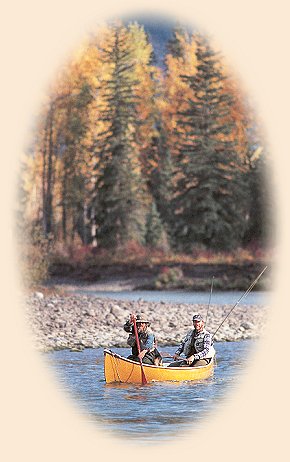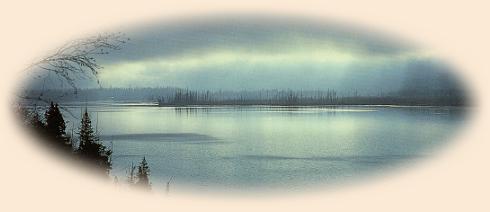Skeena Steelhead
From Fly Fishing British Columbia, distributed by Frank
Amato Publications. Photos from the Great River Series, Skeena River,
published Frank Amato Publications
 Steelhead anglers the world over are drawn each fall
to the rivers of British Columbia's justly famous
Skeena watershed. Rivers such as the Kispiox, where
the world record fly-caught steelhead (33 pounds) was
taken in 1962, leave an indelible impression, but
there are many more where steelhead in the 20-pound-plus
range regularly come to the fly. Water such as the
Zymoetz (Copper), Bulkey, Morice, Suskwa, Babine,
Sustut and the mainstream Skeena itself provide
unmatched fly fishing for steelhead in a range of
ettings and river types, from small wadable streams
through the huge flows that dwarf the angler.
Steelhead anglers the world over are drawn each fall
to the rivers of British Columbia's justly famous
Skeena watershed. Rivers such as the Kispiox, where
the world record fly-caught steelhead (33 pounds) was
taken in 1962, leave an indelible impression, but
there are many more where steelhead in the 20-pound-plus
range regularly come to the fly. Water such as the
Zymoetz (Copper), Bulkey, Morice, Suskwa, Babine,
Sustut and the mainstream Skeena itself provide
unmatched fly fishing for steelhead in a range of
ettings and river types, from small wadable streams
through the huge flows that dwarf the angler.
Most of the fishing takes place during the popular
prime time period between September and the end of
October. Some rivers fish earlier in August and some
will fish longer than October 31 if the weather is
agreeable, but most journeying to Skeena steelhead
waters do so in those two key months. The first
frosts normally arrive about mid-September and by
mid-October temperatures hover near or at freezing
through the day. On high elevation rivers such as
the Sustut and Babine, the freeze will set in even
earlier. By the end of September snow is not
uncommon, especially at higher elevations.
Skeena steelhead enter the mainstem river at Price Rupert
as early as late June, and continue through early September,
with the bulk of the run going through in mid-August. On
average, it takes the fish from three to five weeks to
journey from tidewater to the headwaters of their natal
streams.
The Copper River near Terrace, a heavily glaciated stream,
has steelhead from August through until the snows of late
fall, or until the cold drives anglers from the river,
usually in mid-to late October. Copper River steelhead
are of a good average size, with some fish in the
20-plus-pound range.
The Kispiox River sees its first fish in late August,
but the bulk of the run arrives later in September and
October. Of all the Skeena watershed rivers, the
Kispiox has a higher proportion of larger fish, with
steelhead of 15 to 25 pounds quite common. Some of
its fish reach 30 pounds and larger, so tis is definitely
the river for those looking for huge fish. Its
longstanding international reputation, coupled with
easy access, means its pools and runs are often very
crowded.
The Morice will fish through August and go into late
October or later, depending on weather. This river
holds a large number of small fish in the five-pound
category. Fish of 20-pound weights are rare - a 15-pound
steelhead from the Morice is considered a good fish.
The Morice flows into the Bulkley at Houston, so all
ascending Morice River fish must first travel the Bulkley,
which explains why the Bulkley fishes well in August,
water conditions permitting.
The bulk of fish homing in on the Bulkley arrive through
September and October. Bulkley fish are of a higher
average size than Morice fish, with steelhead in the
eight-to 12-pound range quite common and some chances
of larger fish. The Bulkley's character makes it an
excellent fly fishing river.
The Suskwa, entering the Bulkley upstream of Hazelton,
does not have a big run of steelhead, but those entering
the river are quite large, regularly pushing the scales
over the 20-pound mark. Suskwa fish can be found in the
river as early as mid-August. It is one of the Skeena's
smaller tributaries and is best fished as it drops over
a good rain.
The Babine fishes best from mid-September through October,
but has some fish showing as early as late August. Aside
from the Kispiox, the Babine has the next largest
average-size steelhead, with many fish in the
20-plus-pound range and some going into the 30s.
The Sustut has some early fish running through August
bound for the river's upper watershed. Fish migrating
to those portions of the river below the Bear River
confluence usually arrive through September and October.
Although the run is not as large as other Skeena
tributaries, the river has a good average size, with
a reasonable number of fish weighing 20 pounds and better.
As the steelhead make their way up the Skeena, provided
the mainstem is clear enough, there are fishing opportunities
on some Skeena bars, mostly in the Kitwanga to Kispiox area,
but even the reaches lower down towards Terrace produce
steelhead as long as the river water is reasonable clear.
Rain frequents this watershed during the fall, and it can
be intense enough for all the rivers to go out. The Skeena
is probably the last to go, it will also be the last to
recover after a big storm. Anglers fortunate to be there
at the right time will experience catching large fish in
huge pieces of water - in itself a thrill.
A unique characteristic of Skeena watershed steelhead is
their enthusiasm for rising to flies fished on or just
below the surface in much lower water temperatures than
elsewhere. River temperatures will vary through the
season, but hover in the mid-to low 50s in the early
part of the season, decreasing to about the mid-40s
by mid-October. This varies considerably with elevation
and during years will cold fall weather. The free-rising
nature of Skeena steelhead may be explained by their
multi-year fry-to-smolt residence in fresh water and
the relatively short freshwater growing season. Every
feeding opportunity is taken, including the late-hatching
Diptera flies common to most streams, so Skeena fish
imprint on surface fare early on. Whatever the reasons,
fly fishers can consider themselves fortunate. There
are few more thrilling experiences in steelhead fly
fishing than presenting a fly on or just below the
surface and having a fish rise and take that fly.
Even though the fish are eager to rise to a fly, the
sunk line is still a staple technique. To be successful,
flies and sinktips need to be matched to water depth,
flow and color. Big flies between two and four inches
long or even longer are required. Flies such as the
gg-Sucking Leech, General Practitioner, Woolly Bugger
or the popular Popsicle-type flies all work well.
Usually the darker-toned wet flies produce better
than brighter colors, but much of fly selection is
based on personal preference.
The waked fly is one of the most thrilling techniques
for taking steelhead on the surface and is quite effective
on most Skeena system rivers. The technique is worth a
try through water temperatures down to the mid-40s.
Flies such as the Bomber, Muddler Minnow and Grease
Liner, as well as newer flies of foam-body design
will all produce. The choices are literally endless,
but the important thing is that the fly leaves a wake
as it comes across a run. Flies ranging in size from
#8 through #2 are needed to cover the various water
and light conditions.

The Skeena's free-rising steelhead also provide opportunities
for the traditional dry fly technique. Any fly that floats
well in sizes #8 through #4 is appropriate, but the patterns
that wake well are a bonus as it is then possible to fish
the two techniques on one drift - both dry and waked.
The floating line technique, where the fly is fished
just under the surface on a floating line in a
down-and-across cast, is a very popular method on
many Skeena tributaries. Fly size, as well as the
degree of dressing or sparseness, needs to be
adjusted to match conditions such as water
temperature, clarity, velocity and light conditions.
Darker patterns seem to produce better than those of
lighter tones. For glacial streams or those colored
by rain a large Black GP or Woolly Bugger works well,
especially in poor light. A variety of flies in
#8 to #2 are needed to cover the wide variety of
conditions. The Black Spey, Skunk, Woolly Worm and
Doc Spratley are a few of the traditional flies,
but there are myriad choices.
The nymph-type presentation is used mostly for skittish
fish in low, clear water which is best not approached
with the usual down-and-across cast. For example,
when the water is low and clear in the Kispiox or
the Upper Copper and the fish can be readily spotted,
casting a fly upstream and letting it sink to near
bottom often produces results when nothing else will.
An egg-type pattern fished with a floating line and
strike indicator works as well as anything.
Note: For more on the Skeena, see
The Skeena River in our Great Rivers series.
|

